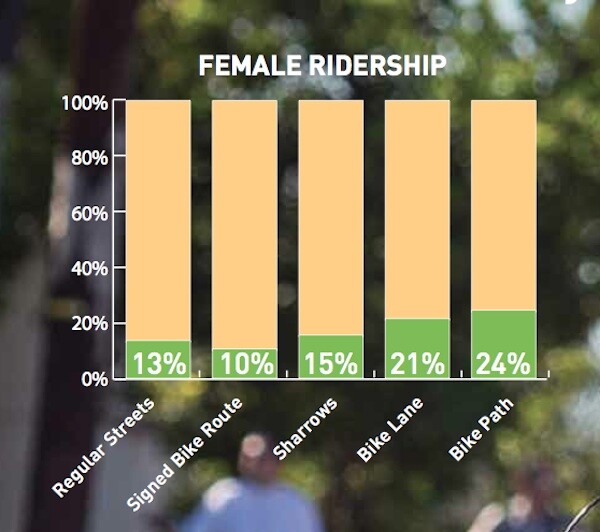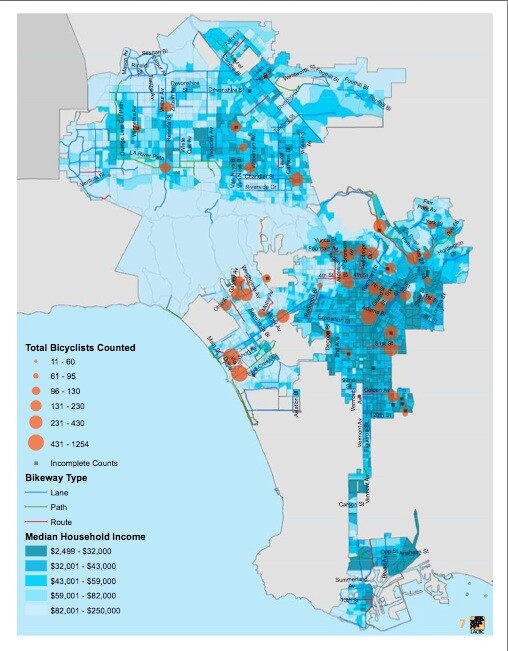Truth matters. Community matters. Your support makes both possible. LAist is one of the few places where news remains independent and free from political and corporate influence. Stand up for truth and for LAist. Make your year-end tax-deductible gift now.
This is an archival story that predates current editorial management.
This archival content was written, edited, and published prior to LAist's acquisition by its current owner, Southern California Public Radio ("SCPR"). Content, such as language choice and subject matter, in archival articles therefore may not align with SCPR's current editorial standards. To learn more about those standards and why we make this distinction, please click here.
Survey: More Angelenos Are Biking But Most Of Them Aren't Women

The numbers are out from the annual survey of bikers: there's a lot of good news, namely that the city's efforts to make the city more friendly to bikers makes a difference. Unfortunately, the survey shows that a lot of those riders are not women and that our bike infrastructure is still pretty patchy.
The Los Angeles County Bicycle Coalition released the results from its annual biking survey. Volunteers with the coalition fanned out across the city to take a survey of bikers at 120 locations different times over several days in September 2013. Altogether, there were 18,000 cyclists counted. The results from the survey are being released just in time for the kick-off of Bike Week. (It comes the same day that the US Census released the results of its own report on commuting.)
The big take-away from the L.A. County biking report seems to be: if you build it, they will come. It might be seem obvious that building bike lanes, bike paths and adding "sharrows" to streets will encourage more people to get on their bikes. But the numbers bear it out: there's been a 7.5% increase in biking over the last two years, and you find more bikers in places where there's infrastructure for them. When you add a bike lane, you find a 103% increase in bikers. With sharrows, which are painted on the street, there's a 132% increase in bike riders. And despite bike paths' limitations—namely, that they're remote and their routes don't tend to be super-useful—they're extraordinarily popular among bikers. They made up 8% of the routes counted but a full quarter of bikers counted in survey.
Only 1 in 5 bikers is a woman. That's a really big gap! It looks like this is part of the larger story about infrastructure: women are especially sensitive to safety issues. There are fewer women biking, but you tend to find more women in places where there's better biking infrastructure: bike paths, bike lanes and sharrows. Here's how it breaks down:

Where you find women who bike (Los Angeles County Bicycle Coalition)
There is one important exception to the "infrastructure encourages biking" rule: signs noting bike routes don't push people to bike more. The survey found that bikers weren't any more likely to be found on a bike route with a sign and nothing else than a street without any kind of signage or biking infrastructure whatsoever.
If when you hear the word "biker," you think of a hipster riding a fixie in Silver Lake, think again. The biggest number of bikers are in low-income neighborhood and near colleges, leading the survey's authors to suggest that a lot of people who choose to bike are doing it because it's affordable. Here's a map of where the survey found bikers:

You're right to think that we're still a pretty car-centric city. The survey notes that the city has moved quickly to become more bike-friendly, but only where it doesn't mess up the all-important driving experience:
Since the 2010 Bicycle Plan, Los Angeles has expanded its bicycle network at an unprecedented rate, at one point exceeding 100 lane miles in one year. However, most of these miles have consisted of bike lanes “where they fit” and sharrows where bike lanes don’t. The result has been a somewhat fragmented bicycle network primarily designed to avoid impacts to motor vehicle delay rather than designed to meet the needs of people who want to ride a bike. This report makes it clear that where bicycle improvements are made, ridership is up, but that citywide growth is limited by the lack of a connected network of safe bikeways accessible to all Angelenos.
Peak biking time is the afternoon. 39% of bikers were counted in the afternoon, leading the authors of the survey to conclude that a lot of people are using their bike to commute. 27% of bikers ride in the morning and there are still plenty of weekend warriors: 34% of bikers were counted on the weekend. To take a big step back, the US Census notes that bikers still make up a slim percentage of commuters: 1% of commuters in Los Angeles ride their bikes to work. That's up from .6% in 2008. As for the rest: 3.7% of Angelenos walked to work, 11% took public transportation, 5.5% worked from home and 77% drove (and some of those people carpooled).
The numbers of bikers is going up, but the level of funding is not. This is a bummer. Los Angeles County has taken some big steps in improving bike infrastructure over recent years, but the coalition says that 1% of transportation funding goes to walking and biking, though one out of every five trips is on foot or bike.







